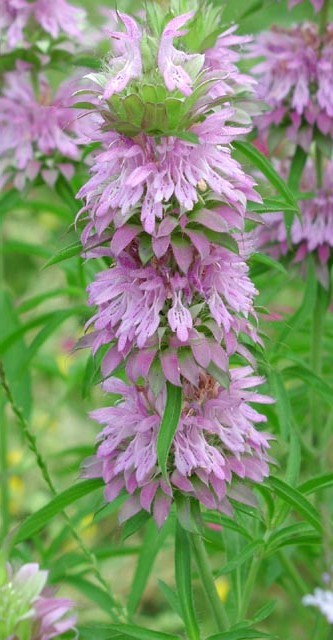Basil beebalm
(Monarda clinopodioides)

Description
Monarda clinopodioides, common name basil beebalm, is a plant species native to Kansas, Oklahoma, Louisiana and Texas. Monarda clinopodioides is an annual herb that can exceed 30 cm (12 inches) in height. Leaves are lanceolate to oblong, tapering at both ends, with small hairs and small teeth. Flowers are born in small glomerules (clumps) of pink or purple flowers and green bracts, born in the axils of the upper leaves. Monarda is a genus of flowering plants in the mint family, Lamiaceae. The genus is endemic to North America. Common names include bergamot, bee balm, horsemint, oswego tea, the first inspired by the fragrance of the leaves, which is reminiscent of bergamot orange (Citrus bergamia). The genus was named for the Spanish botanist Nicolás Monardes, who wrote a book in 1574 describing plants of the New World. Monarda species include annual and perennial herbaceous plants. They grow erect to heights of 20–90 cm (8–35 in). The slender, serrated, lanceolate leaves are oppositely arranged on the square stem, hairless or sparsely hairy, and about 7 to 14 centimeters long. The flowers are tubular and bilaterally symmetric, with a narrow upper lip and a wider lower lip. The wild flowers are single, but some cultivated forms have double flowers. They are hermaphroditic, with male and female structures in each flower. There are two stamens. Inflorescences occur at the top of the stem or emerge from the axils. They are typically crowded head-like clusters of flowers with leafy bracts. Flower color varies, with wild species bearing red, pink, and light purple flowers. M. didyma has bright carmine red flowers, M. fistulosa has pink, and M. citriodora and M. pectinata have pale purple. Hybrids occur in the wild, and they are common in cultivation. Seed collected from hybrids does not yield plants identical to the parent. The crushed leaves of all species exude a spicy, fragrant essential oil. Of the species examined in one study, M. didyma contained the highest concentration of oil. Several species, including Monarda fistulosa and M. didyma, have a long history of use as medicinal plants by many Native Americans, such as the Blackfoot, Menominee, Ojibwa and Winnebago. The Blackfoot recognized the strong antiseptic action of the plants, and used them in poultices for skin infections and minor wounds.
Taxonomic tree:







